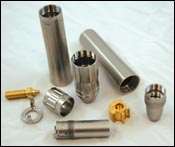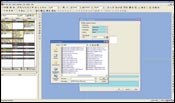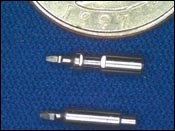Medical Machining Made Simpler
Medtronic Powered Surgical Solutions produces power surgical motors, tools and attachments. CAM with knowledge-based machining capabilities helps them program low volume, complex parts processed on multi-tasking screw machines.
Amongst the hectic lives many of us lead, it’s a relief when we stumble upon something that simplifies it. Any idea, product, tool or software that helps us save time, stay in control and ahead of the game is worth at least some consideration. This is true especially in a business such as manufacturing, where meeting customer demands on a deadline is a priority.
Paul Cihak, a model maker at Medtronic Powered Surgical Solutions (Fort Worth, Texas), streamlined his job in 2005 after he chose to implement Esprit software from DP Technology on a Citizen-Cincom M32 Y Swiss turning center. Together, the machine and the software produce components for surgical motors and attachments used in the medical industry during surgery.
Featured Content
Mr. Cihak says, “Prior to Esprit’s implementation, there was a lot more error, debugging and broken tools.” These problems not only led to aggravation, but more critically, machine downtime.
Medtronic Powered Surgical Solutions produces power surgical motors, tools and attachments, including the Midas Rex Legend Pneumatic and Legend EHS systems. Founded in the mid 1960s, the company, then called Midas Rex, began when surgeons were still using hand saws and hand reamers. Eventually, pneumatic motors in surgery replaced these tools. So in response to industry demand, the company evolved with the times and began producing a pneumatic rotary tool. In order to remain a market leader by constantly improving performance in these motors and tools that continue to get smaller, the company uses the latest stainless and exotic alloys in diminishing tolerances.
Along with the pneumatic rotary tool, Medtronic produces other tools mostly used for neurosurgery and spine surgery. It also is evolving into making products such as hand drills and attachments that are used for hip and joint replacements.
As an employee who creates the prototype models for the company’s parts, Mr. Cihak says Medtronic has low part counts, but very high part numbers. “In the last year, I wrote something like 280 programs,” Mr. Cihak says. His part runs usually consist of only five to eight pieces and last anywhere from 18 seconds using two tools to 40 minutes using 17 tools.
Before the company purchased Esprit software, which it bought around the same time as the Citizen lathe, it was using another software program that was mainly geared towards milling and doing molds. “As far as multi-axis, multi-threaded programming on a lathe was concerned, the old software just couldn’t hack it,” Mr. Cihak explains. “We had to make our parts using seven, eight or nine different operations. So we started to look at a machine that could consolidate all of those operations into a single operation. We needed something that would keep me from sitting at a keyboard for 14 hours to program a part.”
After researching several software options, Medtronic decided to go with Esprit. Esprit’s programming system supports all the features of the most advanced lathes. It has tools such as a detailed time study to help optimize the program. The graphic interface facilitates balancing of operations and finding the most optimized process.
The version of Esprit that Mr. Cihak uses also offers knowledge-based machining (KBM), which enables use of predefined processes. After recognizing machining features on the part, the system will suggest tooling and processes based on previously defined rules. “I have routines set up for my most popular operations and tools. This is a great time saver when I have complex parts,” he explains.
Another benefit the software provides is good customer service, according to Mr. Cihak. “We had the best response from Esprit,” he said. “Before we even bought it, one of DP Technology’s technicians came down from Oklahoma to demonstrate the software to us and show us how to program it. Their support has been absolutely terrific.”
When Mr. Cihak had a few small issues with the software’s post processor, the response he received when he contacted tech support was impressive. “I sent an e-mail to them at 11 p.m., and at 11:15 p.m. I got a response from them offering suggestions. Anytime I have a problem, they’ve always been really quick to help, and they won’t give up until it is fixed. I’ve been very pleased.”
Not only has the support been impressive, but the time saved in programming parts has been as well. Esprit’s complexity eliminates the need to do calculations by hand. “When I first got the Esprit, I programmed one part by hand,” Mr. Cihak explains. “It took about 10 hours. Then I tried programming the same part using Esprit. I think I got the program done in a little less than an hour. Now, I could probably do the same one in 15 minutes using the software.” On average, he says he rarely spends more than 30 minutes programming a part.
Programming isn’t the only area where time is saved by using Esprit. The software has also saved many hours in debugging alone. “On one part, I saved probably 8 hours of debugging time,” Mr. Cihak says.
Because the software keeps the machine’s three coordinate systems running smoothly, there is less margin of error, according to Mr. Cihak. “I’ve got the ability with Esprit to predict where every tool is going to go at any moment in time. There are no surprises.” With the nature of these parts being so small and complex, he needs to have the security of a reliable system. “I can run a boring bar into a hole that is only 0.02 inch bigger than the boring bar, but I know that it is going to pull away from the material exactly where I want it to,” he explains.
The fact that Esprit is upgraded on a regular basis is another appealing aspect of the software. The multiple window view is a new feature of Esprit 2008 that Mr. Cihak especially appreciates. “Now, when you are doing the simulation prior to posting, the software gives you the ability to see multiple windows so you can see more than one view of the simulation. While having two spindles, a gang and a turret all going at the same time, it really makes it nice. That was one upgrade I kept drooling over.”
In Mr. Cihak’s eyes, Esprit software has managed to simplify the machining process in many ways, including time saved fixing errors and broken tools as well as faster programming times. These points, as well as having complete control over the software, and in turn, the machine, are what make the software a sound investment for the company.
RELATED CONTENT
-
Medical Screw Solution Includes More than Cutting Tools
With companies producing so many medical screws, every second saved counts. A turnkey program can help manufacturers machine these parts as efficiently as possible.
-
Advancements in Thread Whirling Tooling Technology
Many understand the advantages of thread whirling on a CNC Swiss-type. However, new tooling technology for this thread-machining process can further improve cycle times and reduce cost per part.
-
Vegetable Oil Improves Machining Of Medical Devices
Production management at this shop speculated that many of the materials used and operations performed might benefit from the higher level of lubricity characteristic of vegetable oils. Any consequent additional capacity and tool life would be a plus.









